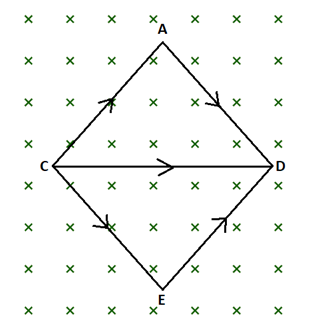
Let current $i=2A$ be flowing in each part of a wire frame as shown in figure. The frame is a combination of two equilateral triangles $ACD$ and $CDE$ of side $1\,m$. It is placed in a uniform magnetic field $B=4\,T$ acting perpendicular to the plane of frame. The magnitude of magnetic force acting on the frame is

$\begin{align}
& A.\,\,24N \\
& B.\,\,Zero \\
& C.\,\,16N \\
& D.\,\,8N \\
\end{align}$

Answer
552.9k+ views
Hint: From the above figure, force in both the equilateral triangles is same as the force applied in their common wire frame. For the wire frame, we can get the magnetic force acting on it using the magnetic force formula.
Formula used:
$F=IlB$, where $I$ is magnitude of current,
$l$ is length of wire, and
$B$ is the magnetic field.
Complete answer:
According to the question, it is given that:
$i=2A$, $l=1\,m$ and $B=4\,T$
From the above figure, it can be deduced that force in both the equilateral triangle is same as the force applied in their common wire frame, which can be written as:
$\overrightarrow{{{F}_{CAD}}}=\overrightarrow{{{F}_{CED}}}=\overrightarrow{{{F}_{CD}}}$
Now,
The magnitude of magnetic force acting on the frame, can be written as:
$\overrightarrow{{{F}_{net}}}=\overrightarrow{{{F}_{CAD}}}+\overrightarrow{{{F}_{CED}}}+\overrightarrow{{{F}_{CD}}}$
Since, $\overrightarrow{{{F}_{CAD}}}=\overrightarrow{{{F}_{CED}}}=\overrightarrow{{{F}_{CD}}}$ and $\overrightarrow{{{F}_{CD}}}=IlB$
Then,
$\overrightarrow{{{F}_{net}}}=(3)\overrightarrow{{{F}_{CD}}}$
$\overrightarrow{{{F}_{Net}}}=3(IlB)$
Substituting the values given in the question, we get:
$\begin{align}
& \overrightarrow{{{F}_{Net}}}=3\times (2\times 1\times 4)\,N \\
& \overrightarrow{{{F}_{Net}}}=(3\times 8)\,N \\
& \overrightarrow{{{F}_{Net}}}=24\,N \\
\end{align}$
Therefore, the correct answer is Option (A).
Note:
Magnetic force acting on a frame is known by everyone. The main part in this question is getting the net force applied on the frame, once the net force is obtained then getting the answer for it is easy. Since, the given diagram shows equilateral triangle, so the net force can be equal as all the edges are of equal length.
Formula used:
$F=IlB$, where $I$ is magnitude of current,
$l$ is length of wire, and
$B$ is the magnetic field.
Complete answer:
According to the question, it is given that:
$i=2A$, $l=1\,m$ and $B=4\,T$
From the above figure, it can be deduced that force in both the equilateral triangle is same as the force applied in their common wire frame, which can be written as:
$\overrightarrow{{{F}_{CAD}}}=\overrightarrow{{{F}_{CED}}}=\overrightarrow{{{F}_{CD}}}$
Now,
The magnitude of magnetic force acting on the frame, can be written as:
$\overrightarrow{{{F}_{net}}}=\overrightarrow{{{F}_{CAD}}}+\overrightarrow{{{F}_{CED}}}+\overrightarrow{{{F}_{CD}}}$
Since, $\overrightarrow{{{F}_{CAD}}}=\overrightarrow{{{F}_{CED}}}=\overrightarrow{{{F}_{CD}}}$ and $\overrightarrow{{{F}_{CD}}}=IlB$
Then,
$\overrightarrow{{{F}_{net}}}=(3)\overrightarrow{{{F}_{CD}}}$
$\overrightarrow{{{F}_{Net}}}=3(IlB)$
Substituting the values given in the question, we get:
$\begin{align}
& \overrightarrow{{{F}_{Net}}}=3\times (2\times 1\times 4)\,N \\
& \overrightarrow{{{F}_{Net}}}=(3\times 8)\,N \\
& \overrightarrow{{{F}_{Net}}}=24\,N \\
\end{align}$
Therefore, the correct answer is Option (A).
Note:
Magnetic force acting on a frame is known by everyone. The main part in this question is getting the net force applied on the frame, once the net force is obtained then getting the answer for it is easy. Since, the given diagram shows equilateral triangle, so the net force can be equal as all the edges are of equal length.
Recently Updated Pages
Master Class 12 Social Science: Engaging Questions & Answers for Success

Master Class 12 Physics: Engaging Questions & Answers for Success

Master Class 12 Maths: Engaging Questions & Answers for Success

Master Class 12 Economics: Engaging Questions & Answers for Success

Master Class 12 Chemistry: Engaging Questions & Answers for Success

Master Class 12 Business Studies: Engaging Questions & Answers for Success

Trending doubts
What are the major means of transport Explain each class 12 social science CBSE

Which are the Top 10 Largest Countries of the World?

Draw a labelled sketch of the human eye class 12 physics CBSE

How much time does it take to bleed after eating p class 12 biology CBSE

Explain sex determination in humans with line diag class 12 biology CBSE

Explain sex determination in humans with the help of class 12 biology CBSE




